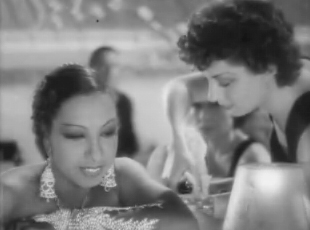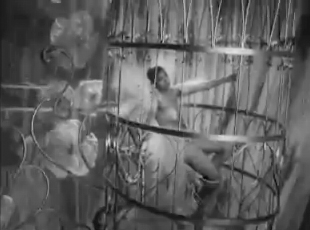|
Felicia McCarren,
"The Use-Value of 'Josephine Baker'" (page 4 of 5)
With the African material, dance steps transposed into a different
context, we could say that Josephine's dancing creates a use value
endimanché: these moves mean something else, somewhere
else, even if here (in Europe, onstage) they are on display. These moves
might also be seen as ultimately rejoining an African space that is the
space of Africa created by photography and on film, the only way many
Europeans would ever see it, as a filmic construct. The African material
is not simply cited by Baker but, on film, reconnects to the space of
Africa as it had been and was being filmed: bringing the world to the
world, le monde tout proche, in the formulation of Louis
Lumière.
This displacement of moves, the notion of the natural created by and
through the artifice of film, what Henri Langlois, founder of the
Cinématheque Française, described as "the natural that only
'primitives' manage to maintain in front of the camera"—is clearly seen
in two cinematic moments from Josephine's oeuvre. First, there is the
famous scene from Princesse Tam Tam in which Alwina strips off
her glamorous garb and, presumably shaming her Pygmalian mentor, Max de
Mirecourt, reveals her real identity to the Parisian elite gathered at
the maharajah's ball.[video] But, of course, the entire scene is the creation
of Max's novel and the set is a movie stage; Alwina's dance is a huge
success, a Busby Berkeley-type floor show that reveals the Princesse de
Parador, alias Alwina, and ultimately, Josephine as its star.

Princesse Tam Tam: Maharajah's Ball [Back to text]
Baker's dancing in the film serves as the key to her perception as an
"uncivilized" colonial; it is posited as telling some inevitable truth
about identity that dressing up cannot hide. The notion of dance as a
revealing gesture, betraying origin and identity, is acted out as Alwina
easily sheds the layer of proper European femininity and descends into a
dance that turns out to be a high-tech industry spectacle, a "natural"
in sync with the drums, but also highly produced. In Le Cinéma
colonial au maghreb, Abdelkader Benali emphasizes the positioning of
Alwina as uncivilized, dancing at the opening of the film for a group of
children at the ruins at Dougga, a site of Roman civilization. It should
be noted that the authenticity of the location shot is belied by the
lack of concern about the cultural specificity of the music and
dancing.
In Zou Zou, Baker plays both a free-spirited circus freak and
a glamorous industry star. But the two stereotypes are also represented
by two other actresses we see on screen: the "natural" uncredited dancer
of color [video] who appears in a port in Manila and the "industry product,"
Miss Barbara, the platinum-haired star played by Ila Meery. In the scene
immediately following the dance in the Manila port, the action shifts to
Zou Zou in France. As she clowns for a little French girl [video], her freedom
of movement—although not the moves themselves—recalls that of the woman
we have just seen with the label "born dancing." Zou Zou jumps from the
table, picks the child up in her arms, spins her around, and lands her
on the ground. Then, during the ensuing dialogue, Zou Zou reaches to
pull down her skirt, caught between her legs, and leaves her hand on her
skirt, a small gesture, but with tremendous resonance.

Zou Zou: Dancing Girl [Back to text]

Zou Zou: Clowning [Back to text]
Baker's back is to the camera, and the skirt is pulled down not for
the viewer, but for an internalized public, represented here by the
little girl. Beyond the film's story of the mainstreaming of Zou Zou the
circus performer, her "whitening" alongside the French working-class
women in the laundry, and the caging and staging of her talent, this
gesture reads as one choreographed by Josephine herself. This small
gesture, which would be unthinkable in her tiny feathered costume on her
swing in her birdcage, reveals that freedom of movement includes a
gesture of propriety as natural as a movement of abandon. While the bird
costume, like the banana costume, stages the question of the liberation
of the body (needing to be caged, or consumed), the "Haiti" number [video]
enacts the structure of this already-present censure, or self-restraint,
that constructs the frame of Josephine's liberating moves. This
self-possession is the other side of the possession often projected onto
her dancing.

Zou Zou: Haiti [Back to text]
Page: 1 | 2 | 3 | 4 | 5
Next page
|